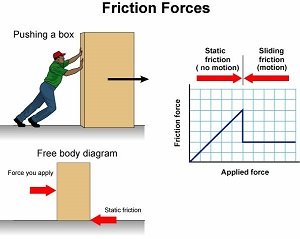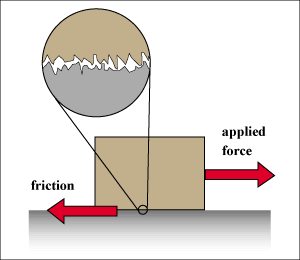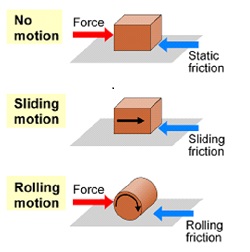Friction Study Guide
INTRODUCTION
Let’s say you go on a hike with your friends over the weekend. On the way to the camping site, your group comes across a creek with lots of wet rocks, and you slip when you accidentally step on one. Later in the evening, it’s getting cold, and you rub your hands together to generate heat before your friend uses their flint and knife to start a campfire. What do you think is a common factor between all these events? No, it’s not you; it’s Friction! 😀
WHAT IS FRICTION?
In simple terms, friction is a resistive force generated between two surfaces in contact when they move past each other. Elementary problems in physics textbooks often ignore friction in its calculations; however, friction is a dominating force in the real world. It helps you walk on the ground, and the lack of friction is why you slip on a wet floor.
Friction between two surfaces generates heat which is why you rub your hands together when you’re feeling cold. Friction can also generate heat that is intense enough to melt objects.
WHAT CAUSES FRICTION?
- Friction occurs because of the microscopic irregularities on the two surfaces that are in contact with each other.
- No matter how smooth the surfaces appear to your eyes, they have peaks and valleys which collide and entangle to create a resistive force at a microscopic level.
- The more the roughness of the surfaces, the stronger will be the friction between them.
- It is important to understand that friction force acts opposite to the applied force, which causes motion.
FACTORS THAT AFFECT FRICTION
Two factors determine friction between surfaces:
-
Coefficient of friction (μ): The coefficient of friction relates to the roughness or the smoothness of the surfaces in contact with each other. The value of μ depends on several factors, such as the smoothness of individual surfaces, wetness, and the nature of the material. The value of μ is different for different types of friction.
-
Normal Force: The second factor is the normal force acting on the surfaces that push the top surface down onto the bottom surface. In a simple system, the normal force is generated by the weight of the objects.
Mathematically the force of friction can be calculated as:
F (friction)= μ×F (normal)
The normal force acting on a body that is on a flat surface will be the object’s weight.
TYPES OF FRICTION
The major two types of friction are:
1. STATIC FRICTION
Static friction is the type of friction between surfaces while they are at rest with respect to each other. If you have ever tried pushing a heavy box across the floor, you would have observed that it takes some amount of force before the box starts sliding. This is the force from static friction.
2. SLIDING FRICTION
This type of friction comes into play once the box starts sliding across the floor. You would also notice that static friction is greater than sliding friction.
The two other types of friction are rolling friction and fluid friction.
CONCLUSION:
- Friction is caused when two surfaces in contact slide over each other.
- Factors contributing to friction include the coefficient of friction (μ) and the normal force.
- Friction always opposes the motion and acts in the direction opposite to the applied force.
FAQs:
1. What kind of force is friction?
Friction is a resistive force generated between two surfaces in contact when they move past each other.
2. How does friction affect our daily life?
Without friction, all things will be sliding about. We can walk because of friction between our feet and the ground; we can grip objects because of the friction between our skin and the object’s surface. Automobile tires and brakes also work on friction.
We hope you enjoyed studying this lesson and learned something cool about Friction! Join our Discord community to get any questions you may have answered and to engage with other students just like you! We promise, it makes studying much more fun! 😎
SOURCES:
- Friction. https://flexbooks.ck12.org/cbook/ck-12-physics-flexbook-2.0/section/3.2/primary/lesson/friction-phys/. Accessed 22 Feb 2022.
- Which fundamental force is behind friction?.https://physics.stackexchange.com/questions/262863/which-fundamental-force-is-behind-friction?rq=1. Accessed 22 Feb 2022.
- Friction. https://ncert.nic.in/textbook/pdf/hesc112.pdf. Accessed 22 Feb 2022.
- Types of Friction. https://byjus.com/physics/types-of-friction/. Accessed 22 Feb 2022.
- Friction. https://byjus.com/physics/friction/. Accessed 22 Feb 2022.



